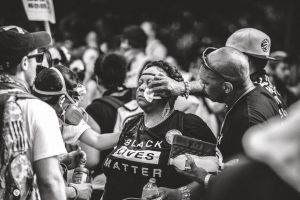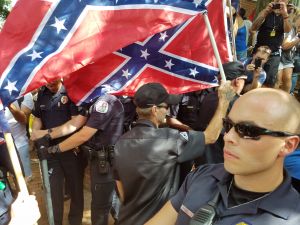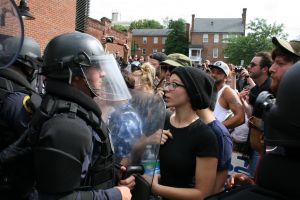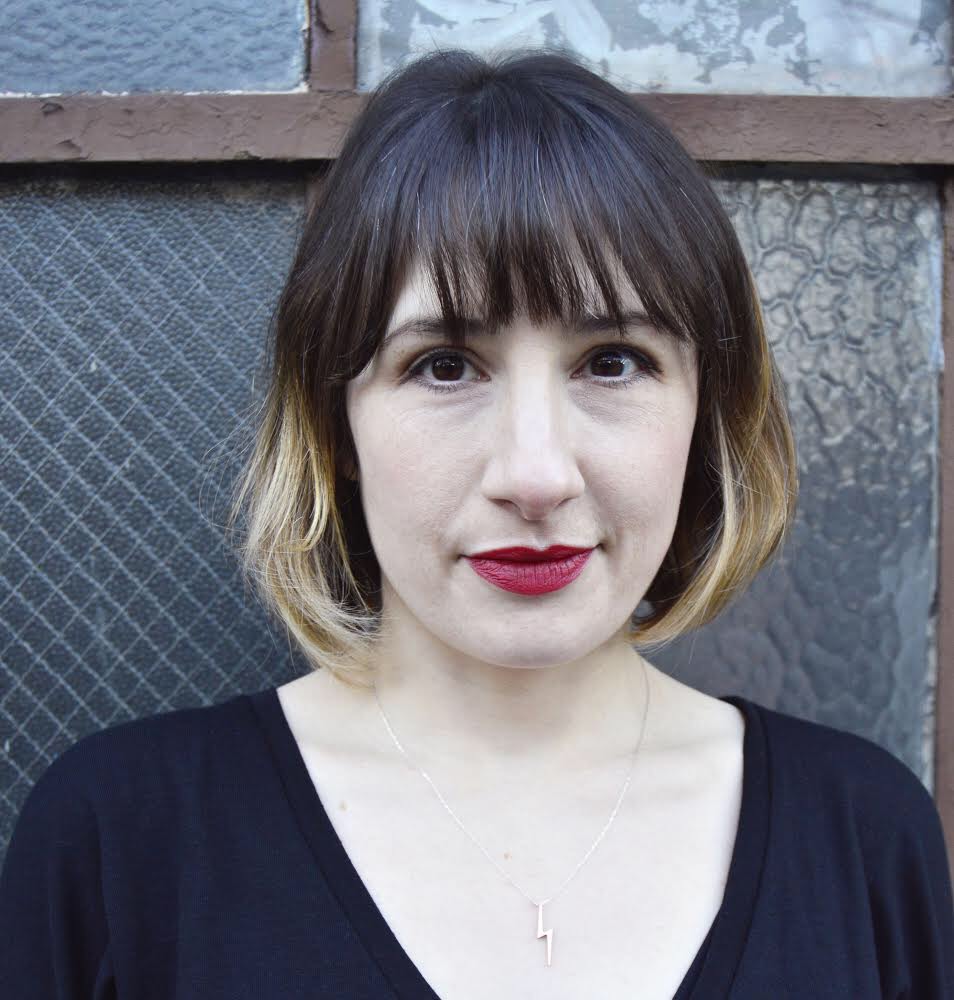
Dueling protests in Charlottesville, Virginia. (Photo by R. Croft)
This Q&A is part of Sarah Jaffe’s series Interviews for Resistance, in which she speaks with organizers, troublemakers and thinkers who are doing the hard work of fighting back against America’s corporate and political powers.
In the wake of Saturday’s protest in Charlottesville, Virginia, Jaffe speaks with counterprotesters Laura Goldblatt, a post-doctoral fellow at University of Virginia, and Mimi Arbeit, an organizer with Showing Up for Racial Justice, Charlottesville, who is working to end white supremacy and gain reparations there.
Goldblatt and Arbeit talk about their experiences at Saturday’s counterrally, which was organized when the Ku Klux Klan announced its intention to stage a march to protest the removal of a statue of Robert E. Lee from a city park. News accounts show that the counterprotesters far outnumbered the 50 or so Klan members, many of whom travelled to Charlottesville from outside the state.
Sarah Jaffe: We are talking on Saturday, after the conclusion of a rally by the Ku Klux Klan and the counter rally that you helped organize. Tell us about how it went.
Laura Goldblatt: I think today people in Charlottesville showed up in an act of community self-defense when the city showed that they would not defend us, nor would the police. People showed up at the park early in the day — there were prayers, there was music, there were people with signs. It was a really moving show of the community coming out despite the fact that the city had officially discouraged people [from] coming and instead organized a variety of alternative events.
Then, the police provided safe passage for the Klan to enter the park. They violently removed protesters who were standing at the entrance that the Klan had intended to use in order to prevent them from entering and from endangering our community. Nonetheless, activists remained chanting at the Klan and lingered long after following the police as the police, again, provided safe passage to the Klan back to their cars. Then, following that, the police set off several chemical agents.
We delayed the Klan. They showed up. Their permit was from 3 p.m. to 4 p.m. and they didn’t even get into the park until like 3:55 p.m. We showed that we are stronger than them, there are more of us then them, and that the state and the threat of racist terrorism can’t keep us away.

Black Lives Matter protestor at Charlottesville, Virginia anti-Klan rally. (Photo by Eze Amos)
Mimi Arbeit: Charlottesville mobilized. The people of Charlottesville came out in high numbers with strong spirit and really showed the vibrancy of our collective energy to resist intimidation and initiate change. What we did see was that the police were there to protect white supremacy. The police chose the Klan over our people. That is excruciating.
SJ: Let’s go back a little bit. Tell us about the history of the Klan in this area. Why did they decide to have this rally here now?
LG: Part of the reason that the Klan is coming back is because of the city council vote to remove the Stonewall Jackson and Robert E. Lee statues from two public parks in the area. The Klan has a really long and intimate history with those statues. The Klan was formed [in Charlottesville] in 1921 at Thomas Jefferson’s grave at Monticello. So they are very closely tied with a long history that goes all the way back to the founding of the United States as a sovereign nation in terms of the history of white supremacy.
They were actually put up overlooking what, at the time, were two prominent black communities as a way to intimidate people of color and Jews and immigrants in the area. They served as a kind of warning. In a lot of ways, the Klan coming back today to this particular park and to rally around this statue was a kind of homecoming for them and shows us the ties between historical white supremacy and its persistence in the city to this day.
MA: To talk about history, let’s start with the person who founded UVA, the University of Virginia. Thomas Jefferson popularized white supremacist ideology in this country. The history of enslavement, the history of Thomas Jefferson raping Sally Hemings is connected to the history of the Lee and Jackson statues that uphold the violence of the confederacy and the oppression of slavery and the Klan is part of that history, too.
The people of Charlottesville need to confront the racist rapist legacy of Thomas Jefferson in order to truly be ready to do the work of racial justice.
SJ: You mentioned briefly the response of the city government to the Klan deciding to have this rally and the police protecting them. Talk a little bit about the different attempts that were made to stop this from happening.

Klan rally over removal of Robert E. Lee statue in Charlottesville, Virginia.
LG: People had been to city council meetings and had demanded that this permit be revoked as a matter of public safety and we reiterated that demand for Aug. 12, which will be an even larger white supremacist really in newly named Emancipation Park, which was formerly called Lee Park. People wrote letters, sent emails, wrote editorials — and the city had said that this is constitutionally protected free speech and that they cannot revoke the permit and these groups are allowed to come despite the threat that they pose to public safety. Instead, the city has told us to ignore them and attend the other events they scheduled but, of course, historically, ignoring white supremacy has not been a winning strategy.
SJ: Tell us about the organizing that has been done on that front since the city refused to revoke the permit. Talk about how the counter rally came together today and the ties in the community that are growing out of this organizing.
LG: There were a bunch of groups that came together to organize: Standing Up for Racial Justice (SURJ), a Black Lives Matter chapter, a recently formed group called Congregate C-Ville, which is a group of faith leaders; EPIC: Equity and Progress; and even some people from the Indivisible chapters of Charlottesville had come to organizing meetings. We had a lot of people working on a lot of different fronts. It took a lot of organizing on everything from action plans, security, to medics, to jail support and then attentive legal response.
MA: SURJ is committed to mobilizing white people to do the work of dismantling white supremacy and supporting the Movement for Black Lives. We have been working in Charlottesville to have conversations to make sure that white people are paying attention and engaging. We are also doing the deep healing work to open ourselves to seeing the lies of white supremacy and to reconcile the harm that has been done for centuries. We’re a working coalition with brilliant and powerful activists in all different kinds of groups — a lot of people just coming out to do the work as individuals, as community members, because it is essential work to do.
SJ: Talk a little bit about the things that you want to see change down in Charlottesville, the organizing beyond just confronting the right.
LG: We have what we call JADE: Justice and Area Drug Enforcement. This is a really inequitable system that targets people of color and gives them really serious criminal sentences for small possession for personal use and has been used to decimate poor and communities of color in Charlottesville. Same thing with the bail bond system. We are at a crisis for public housing in Charlottesville. I should mention that PHAR, the Public Housing Association and Residence is really active here. They have a robust and compelling plan for what public housing should prioritize and what it should look like. And we want them to change the ways that the foster care system works because we see that people of color lose their children at astonishing rates.
MA:This is a mobilizing moment — particularly for white Americans, this moment can be a life-changing moment. If Charlottesville can mobilize in resistance, communities across the country can also mobilize in resistance.

Protester and police officer at anti-Klan rally in Charlottesville, Virginia. (Photo by Alan Goffinski)
SJ: You said there is going to be another larger rally in August. What are some lessons that you took away that you are planning to put into the planning for the next one?
LG: One lesson is that our community is strong and that we are looking out for each other and we are here to protect each other despite the fact that it is very clear that the city and the police are not there to protect us. But, the other lesson is that these monuments are symbols of white supremacy in Charlottesville and it is not enough to call for their removal. We have to push for these material demands. We have to say “You cannot get rid of one without getting rid of the other” and that these two things are linked. We are using this as a way to catalyze communities in Charlottesville.
MA: The rally coming up is Unite the Right March on Charlottesville. This is planned by a set of new white supremacist groups. Several different new white supremacist groups that have been on the rise more recently. The local community is asking Mayor Signer and the city of Charlottesville to revoke the permit for the Aug. 12 rally. This is essential for racial justice and for community safety.
SJ: How can people keep up with you and the work that the coalition is doing, especially leading up to the August rally?
LG: We have a website: www.solidaritycville.com. People should check us out there. They can follow us on Twitter: @SolidCville. They can also check out the Black Lives Matter chapter in Charlottesville by liking their Facebook page. Same thing with SURJ: Standing Up for Racial Justice, the chapter in Charlottesville. I don’t know if Congregate Cville has a Facebook page yet, but hopefully they will soon if they don’t. They can follow all of those.
Interviews for Resistance is a project of Sarah Jaffe, with assistance from Laura Feuillebois and support from the Nation Institute. It is also available as a podcast on iTunes. Not to be reprinted without permission.




